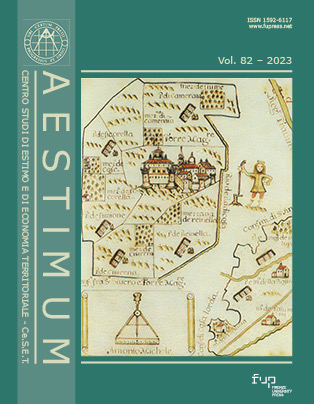The Italian National Strategy for Sustainable Development and the Covid-19 impact: a regional analysis
Published 2023-12-08
Keywords
- Agenda 2030,
- sustainable development,
- Spatial MCDA,
- 5Ps
Copyright (c) 2023 Lucia Rocchi, Luisa Paolotti, Arianna Tiralti, Paolo Stranieri, Antonio Boggia

This work is licensed under a Creative Commons Attribution 4.0 International License.
Abstract
The Italian National Strategy for Sustainable Development plays an important role in the national implementation of the 17 Goals for sustainable development set globally through the 2030 Agenda of the United Nations. The achievement of such goals in Italy is linked to the strategic choices and objectives established at the national level. The purpose of this work is to monitor the performance of the 20 Italian regions in 4 of the 5 areas of the Agenda (People, Planet, Prosperity, Peace) over a period of time ranging from the implementation of the National Strategy to the post-pandemic. To do this, a set of representative indicators was created and a geographical sustainability assessment tool (SSAM) was used, which operates through a multicriteria analysis model perfectly integrated into a GIS environment. The results showed a strong regional variability and a radicalized North-South gap. Moreover, the monitoring between the different years (2017-2019-2021) showed the initially positive impact of the strategy, mainly due to the Planet dimension, but also the negative one that COVID-19 caused to all the regions, with different intensity depending on the dimensions considered.
References
Boggia, A., Massei, G., Pace, E., Rocchi, L., Paolotti, L., Attard, M., 2018. Spatial multicriteria analysis for sustainability assessment: A new model for decision making. Land use policy 71, 281–292. https://doi.org/https://doi.org/10.1016/j.landusepol.2017.11.036
Boroushaki, S., 2017. Entropy-based weights for multicriteria spatial decision-making. Yearb. Assoc. Pacific Coast Geogr. 168–187.
Carrillo M. (2022). Measuring Progress towards Sustainability in the European Union within the 2030 Agenda Framework. Mathematics, 10, 2095. https://doi.org/10.3390/math10122095.
Chen, Y., Yu, J., Khan, S., 2010. Spatial sensitivity analysis of multicriteria weights in GIS-based land suitability evaluation. Environ. Model Softw. 25, 1582-1591.
Cinelli, M., Coles, S.R., Kirwan, K., 2014. Analysis of the potentials of multi criteria decision analysis methods to conduct sustainability assessment. Ecological Indicators 46, 138–148.
D’Adamo I., Gastaldi M., Ioppolo G., Morone P. (2022). An analysis of Sustainable Development Goals in Italian cities: Performance measurements and policy implications. Land Use Policy 120, 106278.
Deng, H., Yeh, C., Willis, R., 2000. Inter-company comparison using modified TOPSIS with objective weights. Computers & Operations Research, 27(10), pp.963-973.
Diakoulaki, D., Mavrotas, G., Papayannakis, L., 1995. Determining objective weights in multiple criteria problems: the CRITIC method. Computers & Operations Research, 22(7), pp.763-770.
Hwang, C.L., Yoon, K., 1981. Multiple Attribute Decision Making: Methods and Applications Springer-Verlag, New York.
Lyytimäki, J., Salo, H., Lepenies, R., Büttner, L., & Mustajoki, J. (2020). Risks of producing and using indicators of sustainable development goals. Sustainable Development, 28(6), 1528–1538. https://doi.org/10.1002/SD.2102
Mascarenhas, A., Coelho, P., Subtil, E., & Ramos, T. B. (2010). The role of common local indicators in regional sustainability assessment. Ecological Indicators, 10(3), 646–656. https://doi.org/10.1016/J.ECOLIND.2009.11.003
Massei G., Rocchi L., Paolotti L., Greco S., Boggia A. (2014). Decision Support Systems for environmental management: A case study on wastewater from agriculture, Journal of Environmental Management (Q1) 146: 491-504. ISSN: 0301-4797, eISSN: 1095-8630; DOI: 10.1016/j.jenvman.2014.08.012.
Ministry of Ecological Transition, 2020, https://www.mite.gov.it/pagina/la-strategia-nazionale-lo-sviluppo-sostenibile
Ministry of Environment and Land and Sea Protection, 2018, https://www.mite.gov.it/pagina/la-snsvs
Ministry of Environment and Land and Sea Protection, 2017. Strategia Nazionale per lo Sviluppo Sostenibile.
Paolotti L., Del Campo Gomis F.J, Agullo Torres A.M, Massei G., Boggia A. (2019). Territorial sustainability evaluation for policy management: The case study of Italy and Spain. Environmental Science and Policy (Q1) 92: 207-219. DOI: 10.1016/j.envsci.2018.11.022.
Papadopoulou- Vrynioti, K., Bathrellos, G.D., Skilodimou, H.D., Kaviris, G., Makropoulos, K., 2013. Karst collapse susceptibility mapping considering peak ground acceleration in a rapidly growing urban area. Eng. Geo 158, 77e88
Rahman, M.A., Rusterberg, B., Gocu, R.C., Lobo Ferreira, J.P., Sauter, M., 2012. A new spatial multi-criteria decision support tool for site selection for implementation of managed aquifer recharge. J. Environ. Manage 99, 61e75
Ravetz J. (2000). Integrated assessment for sustainability appraisal in cities and regions. Environ. Impact Assess .Rev. 20(1), 31–64.
Ricciolini E., Rocchi L., Cardinali M., Paolotti L., Ruiz F., Cabello J.M., Boggia A. (2022). Assessing Progress Towards SDGs Implementation Using Multiple Reference Point Based Multicriteria Methods: The Case Study of the European Countries. Social Indicators Research Open Access, Published on line 31 January 2022. DOI: 10.1007/s11205-022-02886-w.
Rocchi L., Ricciolini E., Massei G., Paolotti L., Boggia A. (2022). Towards the 2030 Agenda: Measuring the Progress of the European Union Countries through the SDGs Achievement Index. Sustainability (Switzerland) Open Access 14(6), Article Number 3563. DOI: 10.3390/su14063563.
Stevens C., Kanie, N. (2016). The transformative potential of the sustainable development goals (SDGs). International Environmental Agreements, 16, 393–396.
UN General Assembly. Transforming Our World: The 2030 Agenda for Sustainable Development. A/RES/70/1. 2015. Available online: https://www.refworld.org/docid/57b6e3e44.html
United Nations Conference on Trade And Development, 2015. Investment Policy Framework For Sustainable Development. United Nations UNCTAD/WEB/DIAE/PCB/ 2015/3.
Zardari N., Ahmed K., Shirazi S., Yusop Z., 2015. Literature Review. In: Weighting Methods and their Effects on Multi-Criteria Decision-Making Model Outcomes in Water Resources Management. Springer Briefs in Water Science and Technology. Springer






